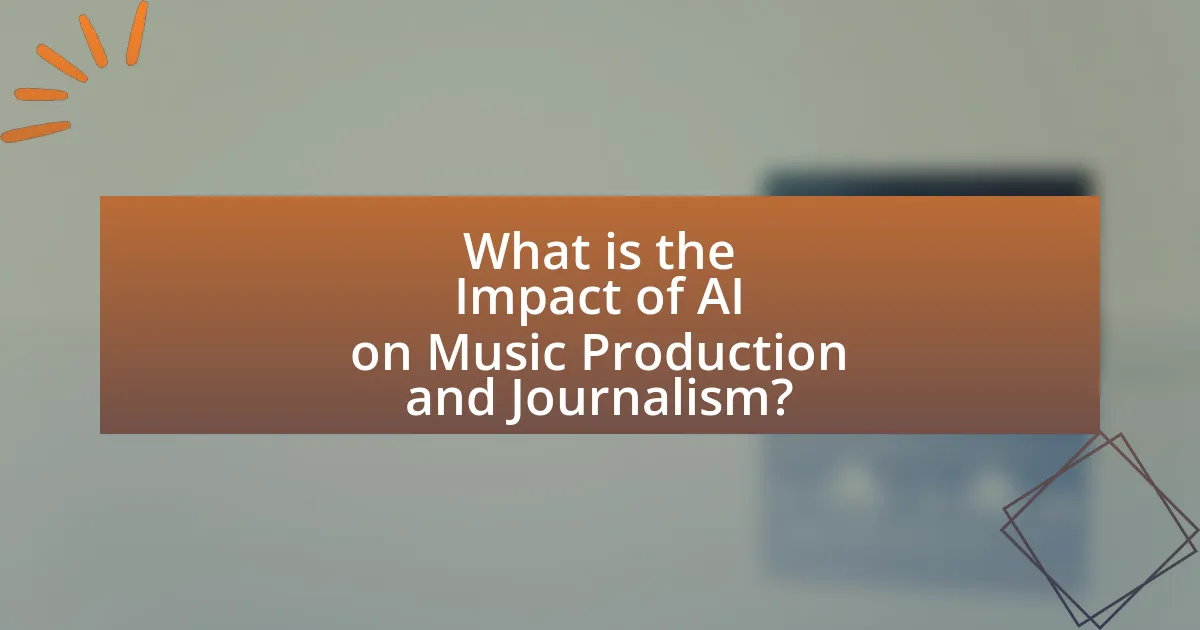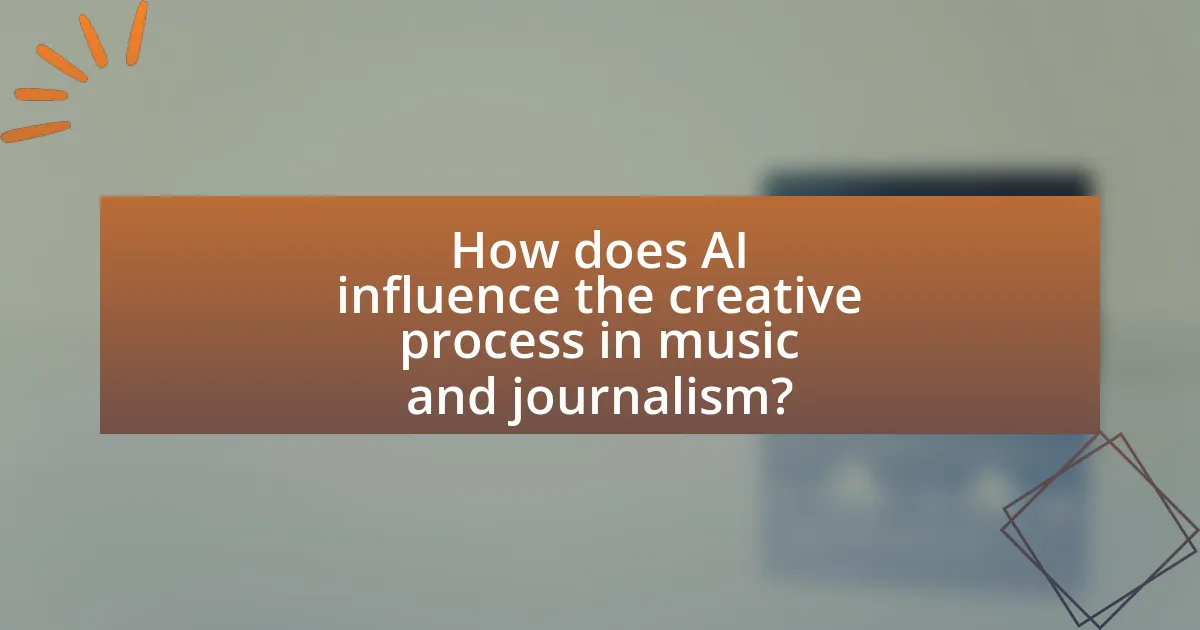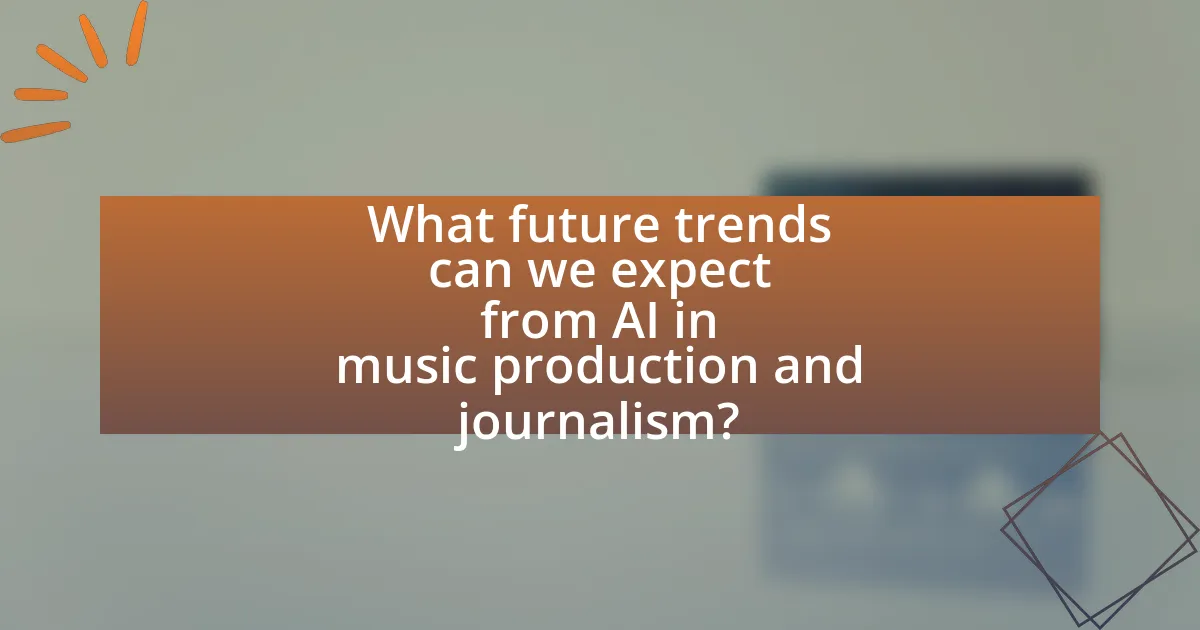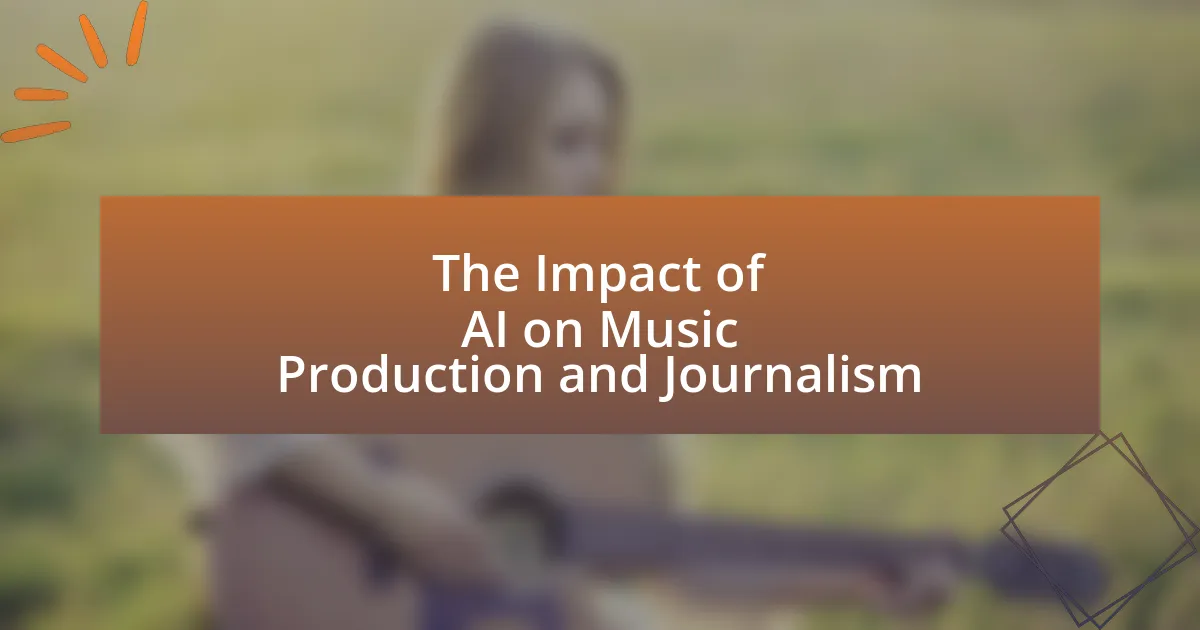The article examines the significant impact of artificial intelligence (AI) on music production and journalism, highlighting how AI enhances creativity, efficiency, and accessibility in both fields. In music production, AI technologies automate tasks such as composition, mixing, and mastering, allowing artists to explore new sounds and styles. In journalism, AI tools facilitate content creation, data analysis, and trend prediction, enabling faster and more accurate reporting. The article also addresses the ethical implications, potential job displacement, and biases associated with AI integration, while outlining future trends and best practices for professionals in these industries.

What is the Impact of AI on Music Production and Journalism?
AI significantly transforms music production and journalism by enhancing creativity, efficiency, and accessibility. In music production, AI algorithms assist in composing, mixing, and mastering tracks, allowing artists to experiment with new sounds and styles quickly. For instance, platforms like Amper Music and AIVA enable users to generate original music using AI, streamlining the creative process. In journalism, AI tools analyze vast amounts of data to generate news articles, summarize information, and even predict trends, as seen with companies like Automated Insights and OpenAI’s GPT models. These advancements improve the speed of content creation and enable journalists to focus on in-depth reporting rather than routine tasks. The integration of AI in both fields exemplifies a shift towards more innovative and efficient practices, reshaping how music is produced and news is reported.
How is AI transforming the landscape of music production?
AI is transforming the landscape of music production by automating various aspects of the creative process, enhancing efficiency, and enabling new forms of artistic expression. For instance, AI algorithms can analyze vast amounts of music data to generate original compositions, assist in mixing and mastering tracks, and even provide real-time feedback to artists during the production process. A notable example is OpenAI’s MuseNet, which can compose music in different styles and genres, showcasing AI’s capability to mimic human creativity. Additionally, AI tools like LANDR offer automated mastering services, significantly reducing the time and cost associated with traditional music production methods. These advancements illustrate how AI is reshaping the industry by making music production more accessible and innovative.
What specific AI technologies are being utilized in music production?
AI technologies utilized in music production include machine learning algorithms, neural networks, and generative adversarial networks (GANs). Machine learning algorithms analyze vast datasets to identify patterns in music, enabling tools like automated mixing and mastering software. Neural networks are employed in applications such as music composition and sound synthesis, allowing for the creation of original music based on learned styles. GANs are particularly effective in generating new audio samples and enhancing sound quality by learning from existing music. These technologies have transformed the music production landscape, making it more efficient and innovative.
How do AI tools enhance creativity in music production?
AI tools enhance creativity in music production by providing innovative algorithms that assist in generating unique sounds and compositions. These tools, such as machine learning models, analyze vast datasets of music to identify patterns and suggest new musical ideas, enabling producers to explore uncharted creative territories. For instance, platforms like AIVA and Amper Music utilize AI to compose original tracks, allowing artists to focus on refining their vision rather than getting bogged down in technical details. This capability not only accelerates the creative process but also introduces novel elements that might not have been conceived through traditional methods, thereby expanding the boundaries of musical expression.
What role does AI play in journalism today?
AI plays a significant role in journalism today by automating content creation, enhancing data analysis, and personalizing news delivery. For instance, AI algorithms can generate news articles from structured data, such as financial reports or sports statistics, allowing journalists to focus on more complex stories. Additionally, AI tools analyze vast amounts of data quickly, helping journalists uncover trends and insights that inform their reporting. According to a 2021 report by the Reuters Institute for the Study of Journalism, 58% of news organizations are using AI for various tasks, indicating its growing importance in the field.
How is AI changing the way news is gathered and reported?
AI is transforming news gathering and reporting by automating content creation, enhancing data analysis, and personalizing news delivery. News organizations utilize AI algorithms to analyze vast amounts of data quickly, identifying trends and breaking news faster than traditional methods. For instance, the Associated Press employs AI to generate thousands of earnings reports, allowing journalists to focus on in-depth stories. Additionally, AI-driven tools like natural language processing enable real-time fact-checking and sentiment analysis, improving the accuracy and relevance of news. This shift not only increases efficiency but also tailors news content to individual preferences, enhancing audience engagement.
What are the ethical implications of using AI in journalism?
The ethical implications of using AI in journalism include concerns about accuracy, bias, accountability, and the potential erosion of trust in media. AI systems can generate news articles and analyze data, but they may inadvertently propagate misinformation if not properly supervised. For instance, a study by the Tow Center for Digital Journalism highlights that AI can reflect and amplify existing biases present in training data, leading to skewed reporting. Additionally, the lack of transparency in AI algorithms raises questions about who is responsible for the content produced, complicating accountability. These factors collectively challenge the integrity of journalism and the public’s trust in news sources.
What are the potential challenges of integrating AI into these fields?
The potential challenges of integrating AI into music production and journalism include issues related to creativity, ethical concerns, and job displacement. In music production, AI may struggle to replicate the nuanced creativity and emotional depth that human artists bring, potentially leading to homogenized soundscapes. In journalism, AI-generated content raises ethical questions regarding accuracy, bias, and accountability, as algorithms may inadvertently propagate misinformation. Additionally, both fields face the risk of job displacement, as automation could replace roles traditionally held by humans, impacting employment opportunities. These challenges highlight the need for careful consideration and regulation as AI technologies are adopted in these creative industries.
What concerns exist regarding job displacement in music and journalism due to AI?
Concerns regarding job displacement in music and journalism due to AI primarily revolve around the automation of creative tasks, which threatens traditional roles. In music, AI can generate compositions and assist in production, potentially reducing the demand for human musicians and producers. For instance, AI-generated music platforms have emerged, allowing users to create songs without human input, which can lead to fewer opportunities for artists. In journalism, AI tools can automate news writing and data analysis, resulting in fewer jobs for reporters and editors. A study by the Pew Research Center indicates that 76% of journalists are worried about AI’s impact on their profession, highlighting fears of reduced job security and the quality of content. These concerns underscore the significant implications of AI on employment in both fields.
How can biases in AI algorithms affect music and news content?
Biases in AI algorithms can significantly skew music and news content by promoting certain genres or narratives while marginalizing others. For instance, if an AI algorithm is trained predominantly on popular music from specific demographics, it may favor those styles in its recommendations, leading to a lack of diversity in what listeners are exposed to. Similarly, in news content, algorithms that prioritize engagement metrics may amplify sensationalist stories, thereby distorting public perception and limiting the representation of critical but less popular issues. Research by the AI Now Institute highlights that biased algorithms can perpetuate stereotypes and reinforce existing inequalities, demonstrating the real-world implications of these biases in both music and journalism.

How does AI influence the creative process in music and journalism?
AI significantly influences the creative process in music and journalism by enhancing productivity and enabling new forms of expression. In music, AI algorithms can analyze vast datasets of existing compositions to generate original melodies, harmonies, and arrangements, allowing artists to explore innovative sounds and styles. For instance, platforms like OpenAI’s MuseNet can create complex musical pieces across various genres, demonstrating AI’s capability to augment human creativity.
In journalism, AI tools assist in data analysis, content generation, and audience engagement. Natural language processing algorithms can summarize articles, generate news reports, and even personalize content for readers, thereby streamlining the writing process and allowing journalists to focus on in-depth analysis and storytelling. A study by the Reuters Institute for the Study of Journalism highlights that 60% of journalists believe AI will enhance their work by automating routine tasks, thus fostering creativity in reporting.
What are the benefits of using AI in music composition?
The benefits of using AI in music composition include enhanced creativity, increased efficiency, and personalized music experiences. AI algorithms can analyze vast amounts of musical data, generating unique compositions that may inspire human musicians. For instance, AI tools like OpenAI’s MuseNet can create original pieces across various genres, demonstrating the technology’s ability to produce high-quality music. Additionally, AI can streamline the composition process by automating repetitive tasks, allowing composers to focus on more complex creative decisions. Research from the Journal of New Music Research highlights that AI-assisted composition can lead to innovative musical styles and techniques, showcasing its potential to transform the music industry.
How does AI assist musicians in generating new ideas?
AI assists musicians in generating new ideas by providing tools that analyze existing music patterns and suggest innovative compositions. These AI systems utilize machine learning algorithms to study vast datasets of musical works, identifying trends and styles that can inspire new creations. For instance, platforms like OpenAI’s MuseNet and Google’s Magenta can generate melodies and harmonies based on user inputs, allowing musicians to explore unique musical directions. Research has shown that AI can enhance creativity by offering unexpected combinations and variations, thereby expanding the creative possibilities for artists.
What are the limitations of AI-generated music?
AI-generated music has several limitations, including a lack of emotional depth, creativity constraints, and reliance on existing data. These systems often struggle to replicate the nuanced emotional expression found in human-created music, as they primarily analyze and synthesize patterns from pre-existing compositions. Additionally, AI models are limited by the quality and diversity of their training data, which can lead to repetitive or formulaic outputs. Research indicates that while AI can generate technically proficient music, it often lacks the originality and innovative spark that human composers bring to their work, as highlighted in studies on algorithmic creativity.
How is AI reshaping content creation in journalism?
AI is reshaping content creation in journalism by automating news writing, enhancing data analysis, and personalizing content delivery. Automated systems like OpenAI’s GPT-3 can generate articles based on data inputs, allowing for rapid reporting on events such as sports scores or financial updates. Additionally, AI tools analyze large datasets to uncover trends and insights, enabling journalists to create more informed and relevant stories. For instance, the Associated Press uses AI to produce thousands of earnings reports, significantly increasing efficiency. Furthermore, AI algorithms personalize news feeds for readers, tailoring content to individual preferences, which can lead to higher engagement rates. These advancements illustrate how AI is transforming traditional journalism practices, making them more efficient and responsive to audience needs.
What tools are journalists using to automate reporting?
Journalists are using tools like Automated Insights, Wordsmith, and Google Cloud Natural Language to automate reporting. Automated Insights enables the generation of narratives from data, allowing journalists to produce articles quickly based on structured information. Wordsmith, another tool, uses natural language generation to create reports and summaries from data sets, enhancing efficiency in content creation. Google Cloud Natural Language provides advanced text analysis capabilities, helping journalists to extract insights and automate the processing of large volumes of text. These tools exemplify how AI is transforming journalism by streamlining the reporting process and enabling faster content delivery.
How does AI improve the accuracy of news articles?
AI improves the accuracy of news articles by utilizing advanced algorithms to fact-check information and analyze data sources in real-time. These algorithms can cross-reference multiple credible sources, reducing the likelihood of misinformation. For instance, AI tools like Google’s Fact Check Explorer and Full Fact’s automated fact-checking system have demonstrated significant effectiveness in identifying inaccuracies in news content, leading to a more reliable dissemination of information. Furthermore, AI can analyze patterns in reporting, helping journalists identify biases and ensuring a more balanced presentation of facts.

What future trends can we expect from AI in music production and journalism?
AI in music production and journalism is expected to enhance creativity, streamline workflows, and personalize content. In music production, AI tools will increasingly assist in composing, mixing, and mastering tracks, allowing artists to experiment with new sounds and styles efficiently. For instance, platforms like AIVA and Amper Music already demonstrate AI’s capability to generate original compositions, which can lead to a broader range of musical innovation.
In journalism, AI will likely improve content generation and data analysis, enabling journalists to produce articles faster and with greater accuracy. Tools like OpenAI’s GPT-3 have shown potential in drafting news articles and summarizing information, which can help news organizations meet the demand for timely reporting. Furthermore, AI-driven analytics will assist journalists in identifying trends and audience preferences, leading to more targeted and relevant content.
These trends indicate a future where AI not only supports but also transforms the creative processes in both music and journalism, making them more efficient and responsive to audience needs.
How will AI continue to evolve in the music industry?
AI will continue to evolve in the music industry by enhancing music creation, personalization, and distribution processes. Advanced algorithms will enable AI to compose original music, analyze listener preferences, and generate tailored playlists, thereby improving user engagement. For instance, platforms like Spotify utilize AI-driven recommendation systems that analyze user behavior to suggest songs, which has been shown to increase user retention rates significantly. Furthermore, AI tools are being developed to assist artists in the production process, allowing for more efficient mixing and mastering, as seen with software like LANDR. This evolution will lead to a more dynamic and responsive music ecosystem, where AI not only supports artists but also shapes the listening experience.
What innovations are on the horizon for AI in music production?
Innovations on the horizon for AI in music production include advanced generative algorithms, real-time collaboration tools, and enhanced audio analysis capabilities. Generative algorithms, such as those developed by OpenAI and Google, are increasingly capable of creating original compositions and soundscapes that mimic human creativity. Real-time collaboration tools are being designed to allow musicians and producers to work together seamlessly across distances, leveraging AI to suggest improvements and variations during the creative process. Enhanced audio analysis capabilities enable AI to dissect and understand complex musical structures, leading to more sophisticated mixing and mastering techniques. These advancements are supported by ongoing research in machine learning and neural networks, which continue to evolve and improve the efficiency and creativity of music production.
How might AI change the way music is consumed by audiences?
AI will significantly change the way music is consumed by audiences through personalized recommendations and enhanced accessibility. Algorithms analyze user data, such as listening habits and preferences, to curate tailored playlists, making it easier for listeners to discover new artists and genres. For instance, platforms like Spotify and Apple Music utilize AI-driven recommendation systems that account for over 30% of user engagement, demonstrating the effectiveness of this technology in shaping listening experiences. Additionally, AI can facilitate real-time music streaming and interactive experiences, allowing audiences to engage with music in innovative ways, such as through virtual concerts or AI-generated music. This evolution in consumption patterns reflects a shift towards a more individualized and immersive musical landscape.
What future developments can we anticipate in AI-driven journalism?
Future developments in AI-driven journalism will likely include enhanced automation of news writing, improved personalization of content, and advanced data analysis capabilities. Automation tools, such as natural language generation algorithms, are already being used by organizations like the Associated Press to produce thousands of financial reports quickly and accurately. Personalization will enable news outlets to tailor content to individual preferences, increasing engagement and relevance. Additionally, AI’s ability to analyze vast datasets will facilitate deeper investigative journalism, allowing reporters to uncover trends and insights that were previously difficult to identify. These advancements are supported by ongoing research in AI technologies, which continue to evolve and integrate into journalistic practices.
How will AI impact the credibility of news sources?
AI will significantly impact the credibility of news sources by enabling the rapid generation and dissemination of information, which can lead to both enhanced fact-checking capabilities and increased misinformation. AI tools can analyze vast amounts of data quickly, allowing news organizations to verify facts and sources more efficiently, thereby improving the accuracy of reporting. However, the same technology can also be exploited to create deepfakes and misleading content, undermining trust in legitimate news outlets. For instance, a study by the Pew Research Center found that 64% of Americans believe that fabricated news stories cause confusion about the facts, highlighting the dual-edged nature of AI’s influence on credibility.
What role will AI play in combating misinformation in journalism?
AI will play a crucial role in combating misinformation in journalism by enhancing fact-checking processes and improving content verification. AI algorithms can analyze vast amounts of data quickly, identifying patterns and inconsistencies that may indicate false information. For instance, tools like Google’s Fact Check Explorer utilize AI to cross-reference claims with verified sources, significantly reducing the spread of misinformation. Additionally, AI can assist journalists by flagging potentially misleading content before publication, thereby promoting accuracy and accountability in reporting.
What best practices should professionals follow when integrating AI into their work?
Professionals should prioritize transparency, ethical considerations, and continuous learning when integrating AI into their work. Transparency involves clearly communicating how AI tools function and the data they utilize, which fosters trust among stakeholders. Ethical considerations include ensuring that AI applications do not perpetuate biases or infringe on copyright, as highlighted by the 2021 report from the AI Now Institute, which emphasizes the importance of fairness in AI systems. Continuous learning is essential, as the AI landscape evolves rapidly; professionals should engage in ongoing education to stay updated on best practices and emerging technologies, supported by findings from the McKinsey Global Institute, which indicate that organizations that invest in employee training on AI see a 20% increase in productivity.
